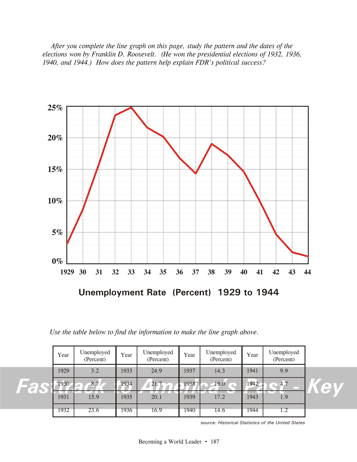| Fasttrack
to America's Past Teacher Key |
|
| Fasttrack
to America's Past Teacher Key |
|
 Page 186  Page 187 |
Pages 186
& 187 - Charting the New Deal and Unemployment The New Deal programs, page 186 Students will need a #2 pencil for this
chart. What the chart shows Making the chart, page 187 Students will need a color pencil to complete the line graph on this page. Red is a good choice.Students should study the table, then neatly place dots for the data and connect the dots with straight lines. Teachers may want students to make small marks along the graph line to show the years of the elections won by Franklin Roosevelt. The years were: 1932, 1936, 1940, and 1944. FDR died in 1945. That will help students answer the discussion question. What the chart shows The graph shows the sharp and disastrous jump in unemployment during the early years of the Great Depression. It also shows the partial recovery under the early New Deal programs, then another rise in unemployment in 1937. Several new programs, sometimes described as the "Second New Deal," helped bring the unemployment rate down again. But full recovery did not come until the nation began to prepare for, and then enter, World War Two. (The war began in 1939; the U.S. entered after the attack on Pearl Harbor in 1941.) Remember that the unemployment rate does not include people who have given up looking for work. If the figures included people who had lost hope of finding a job, and were no longer even looking, the situation would look even worse. Group discussion question, page 187 The pattern of unemployment and recovery shows that Franklin Roosevelt benefited from the fact that joblessness was rapidly rising as the election of 1932 approached. President Herbert Hoover hardly had a chance as public opinion turned against him. FDR's New Deal programs helped bring down unemployment in the years of his first term. As the election of 1936 approached, voters were certainly hopeful that the improvement would continue if Roosevelt remained president. Unemployment rose again not long after that election, but fell back again in time for the 1940 election. The approach of World War Two also no doubt helped convince many voters that FDR should remain in charge. Unemployment stayed low during the war, as a result of the need for workers in factories producing weapons and supplies for the military. |
|
Copyright Notice
Copyright 2018 by David Burns. All rights reserved. Illustrations and reading selections appearing in this work are taken from sources in the public domain and from private collections used by permission. Sources include: the Dover Pictorial Archive, the Library of Congress, The National Archives, The Hart Publishing Co., Corel Corporation and its licensors, Nova Development Corporation and its licensors, and others. Maps were created or adapted by the author using reference maps from the United States Geological Survey and Cartesia Software. Please see the home page for this title for more information. |